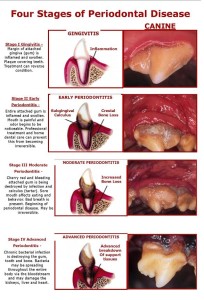We all joke about “doggy breath,” but the fact is that nasty breath may be telling you something is wrong in your pup’s mouth.
According to Dr. Wendy C. Brooks, DVM, DipABVP, “a full 85% of pets have periodontal disease by age 3.” (www.veterinarypartner.com)
The Signs
Unfortunately, periodontal disease has really no signs except for halitosis (bad breath) in its early stages (http://www.avdc.org).
“In progressed cases your pet may refuse to eat, unable to chew. Look for redness in the gums, discoloration of the teeth, or excessive drooling,” adds Dr. Denise Petryk, DVM, Director of Veterinary Services at Trupanion.
According to the American Veterinary Dental College, “Periodontal disease begins when bacteria in the mouth form a substance called plaque that sticks to the surfaces of the teeth. Subsquently, minerals in the salvia harden the plaque into dental calculus (tarter), which is firmly attached to the teeth. Tartar above the gum line is obvious to many owners, but is not of itself the cause of disease.”
When that plaque and tartar spread to below the gum line, the body’s own immune system attacks the bacteria but ends up damaging the supporting tissue of the tooth as well. This is where periodontal disease sets in.
This chart shows the 4 stages of Peridontal Disease clearly. (Source: Prairie View Animal Hospital)
Dr. Jan Bellows, DVM DipAVDC for All Pets Dental Clinic, describes the four stages thusly:
- Stage 1 gingivitis
- Stage 2 early periodontitis-less than 25% support loss
- Stage 3 established periodontitis- between 25-50% support loss
- Stage 4 advanced periodontitis- greater than 50% support loss

Dr. Bellows explains that “as plaque ages and gingivitis develops then periodintitis (bone loss) occurs.” Stage 1 is reversibly, peridontitis (stages 2-4) is not. (veterinarypartner.com)
By Stage 3, your dog is probably going to lose some teeth. By Stage 4, your dog’s life could be in danger due to bacteria being spread throughout the body via the bloodstream.

